|
18th c American Furniture...
The furniture displayed here is bench made - by hand - with the same kind of hand tools and techniques as used in the 18th century.
Meticulous care is taken to reproduce these select examples as exhibiting the most exemplary motifs of Colonial American craftsmanship. This care extends from
selection of wood for special characteristics, to expected tool marks, to the exacting finishing including correct color, materials and finish appearance. Attention is
also given to careful selection of hardware, whether brass or iron. Each piece is carefully aged to simulate 250 years of expected wear so as to unobtrusively blend with surrounding
antiques.
Every effort is made to faithfully reproduce these magnificent examples from private and public collections. Faithful reproduction is the premier focus here. These pieces
are not made quickly, for only a few select pieces are reproduced each year, but they are made correct to the period. We hope you enjoy these pieces in trust for your future generations
as much as many in the past have been fortunate to value and appreciate them.
Special requests are certainly invited. Please contact us for more information.
|
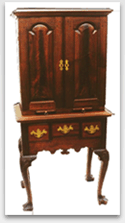

|
Philadelphia Queen Anne Spice Box on Frame, c.1740's
Originally there were few of these formal and sophisticated valuables boxes produced in colonial America and they would have graced a home of some wealth
and reputation. This walnut reproduction is built with similar hand tools and techniques as in the 18th century. It has hand carved trifid feet with a shell on each
front knee. Note the common Philadelphia QA motif of a "whale's tail" in the center of the frame's skirt. It also has tombstone raised panel doors made from
bookmatched crotchwood. The upper doors are lockable and the base is separate from the top section. There are many small interior drawers made from curly walnut,
dovetailed by hand, originally designed for storage of expensive spices or other valuables, as well as several hidden drawers and two candle slides. It has a hand
applied shellac finish.
H 57" W 23.3/4" D 10.5/8"
|
|
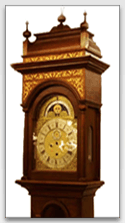

|
Philadelphia Sarcophagus Tall Case Clock
Tall case clocks were considered to be "luxury" items in the colonial household through the 1700's. This outstanding sarcophagus top tall case clock (also known as a caddy top)
was originally built by Peter Stretch c1720-30 in Philadelphia. Stretch was one of Philadelphia's earliest clock makers. He and later his two sons (also clockmakers) were
regarded in Philadelphia as a leading craftsman and all were very active in civic and Quaker affairs. This beautiful walnut reproduction features a blind fretwork frieze, a hand blown
glass rondel in the waist door, lots of hand made molding and hand blacksmithed rat tail hinges. The sarcophagus molding on the hood is quite distinctive of a very early clock.
The brass dial is faithfully recreated by David Lindow. This is a commanding piece in a household even today.
H 109" W 23" D 11.1/2"
|
|
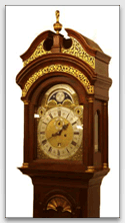

|
Newport, Rhode Island Tall Case Clock c.1750
The original works of this clock were built by James Wady from Newport and the original case was built by Job Townsend, also from Newport. This mahogany reproduction is mostly constructed from one carefully
laid-out mahogany board. The reproduction brass dial is exceptional and faithful as the original in that it has a minute hand, a tidal dial and a strike silent dial, made by David Lindow.
This clock has a double cornice, a rare feature. There are two gold leafed friezes, gilded column capitals and a gilded carved shell. The shell carved on the waist door is a simple Newport shell but
executed by relieving most of the door to enhance the shell. The clock terminates with beautiful ogee bracket feet.
H 101.7/8" W 20.1/2" D 10.1/2"
|
|
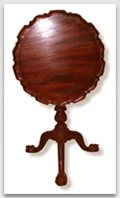

|
Philadelphia Chippendale Pie Crust Tilt Top Tea Table c.1770's
This reproduction Philadelphia Chippendale Pie Crust Tilt Top Tea Table is constructed from Mahogany. The single board top is turned on an outboard lathe and then the "pie crust" scalloped delicate edge is hand
carved. The birdcage support is a common Philadelphia characteristic. There is elaborate carving and fluting on the post. The carved cabriole legs have elongated flowing acanthus carvings terminating
in a ball and claw foot. This is a diminutive version of a very distinguished colonial tea table.
H 28.5/8" W 25" D 25"
|
|
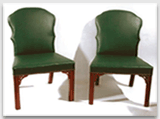

|
Philadelphia French Back Stools
These two matching Philadelphia French Back Stools (Chairs) are constructed with Mahogany as the primary wood. The profiled Marlborough legs are made with a special dedicated wooden hand
plane. Note the delicate corner fretwork at the junction of the legs and the seat. These extremely comfortable chairs have a hand applied shellac finish and are upholstered
in supple leather. The originals were built by Thomas Affleck for John Penn when he resided at Cliveden.
H 38" W 24.3/4" D 26"
|
|
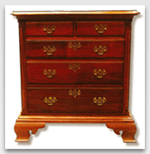

|
Philadelphia Chippendale Bachelor's Chest c.1760-1780
This beautiful walnut reproduction diminutive chest of drawers is constructed from wide, one-piece walnut sides and top. Note the embellishment of carved corners on the top, graceful yet strong ogee bracket fee,
and canted, fluted quarter columns. Albert Sack, in "The Fine Points of Furniture" says the original's "compact scale of the case and superb proportion elevate this standard from to exalted staus." Hand applied shellac finish.
H 33.5/8" W 33.1/2" D 20"
|
|
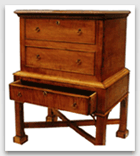

|
Philadelphia Cellaret/Spirits Box/Bottle Case
This unusual piece usually tends to be more Southern in flavor and predominance, but great examples also were made in Philadelphia, as is the original from which this piece is copied.
The cellaret/spirits box/bottle case was the storage container for the 18th century household's storage of spirits, a necessary component of the colonial home. The interior partitions are sized to hold a
dozen 18th century glass bottles. The top section lifts up for access and the base has a lockable drawer. There are pierced corner brackets joining the
Marlborough legs to the lower carcase. Note the half blind hand cut dovetails all around the upper box, a tedious process. This piece can be built from many varieties of wood, such as curly maple, walnut
cherry or mahogany. This particular piece is constructed from figured maple.
H 32.1/2" W 23" D 16.1/4"
|
|
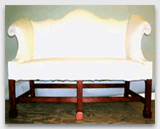

|
Philadelphia Chippendale Camelback Sofa
This outstanding sofa has a peaked back, molded Marlborough legs, a serpentine front and C-scroll arms. These peaked back sofas
"are justly recognized as the top of the line. This example has dynamic impact due to its compact size and superb lines."
(Albert Sack, New Fine Points of Furniture.) Currently pictured in the muslin. Mahogany.
H 38.3/8" W 71" D 33"
|
|
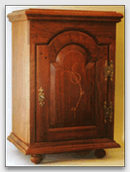

|
Philadelphia/Chester County Queen Anne Valuables Box c.1730-1740
This box is an outstanding example of one of the finest genres of boxes ever made - the Pennsylvania Spice Box, or Valuables Box. This box has a tombstone raised panel door embellished with a typical
18th century Chester County decorative motif on the exterior panel. It is a dovetailed box with small interior drawers showcased with an arched arcade and the surprise of hidden drawers. Bun feet and brass
reproduction drops from the William and Mary period maintain very early motifs that are skillfully blended with more modern Queen Anne features. Though these boxes appear to be simple, the execution of the
joinery and typical embellishment demand advanced skill. Though spice boxes were found in the early colonial New England home, they were and remained very popular into later
years in Southeastern PA. Walnut, White Pine and Atlantic White Cedar. This entire piece is constructed and finished in the 18th century manner.
**Commissions available to commemorate a special occasion such as a birth or marriage.
H 21.5/8" W 14.1/2" D 10.5/8"
|
|
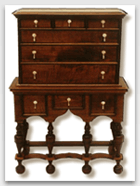

|
Philadelphia William and Mary Miniature High Chest of Drawers (Spice Box) c.1695-1725
This rare walnut, white cedar and pine high chest is quite the eye-catcher. While the English would have painted or veneered much of this style of furniture, the Philadelphia cabinetmakers chose to make
it in the solid. It is most unusual from the other limited known originals of this style in that it has all drawers in increasing heights in the upper section, rather than other combinations of drawers and doors.
This particular piece has hand-made sterling silver back plates and drops. The top row of three drawers all have Quaker locks, also known as Spring Locks.
Finished with hand applied shellac.
H 29.1/2" W 21" D 9"
|
|
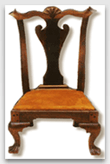

|
18th c Philadelphia Queen Anne Child's Chair
Formal seating furniture for a child is considered very rare in the antiques world. Most any search into fine Queen Anne or Chippendale American Antique Furniture
will probably not picture or even discuss a child's chair - because they are that rare! The carved crest, cabriole legs and trifid feet are quite exceptional. Leather slip seat. Walnut.
H 29.3/8" W 16" D 16"
|
|
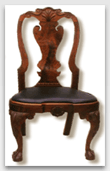

|
Philadelphia Queen Anne Side Chair c.1740-1750
This magnificent chair is a "superb example of the best in colonial chair making" according to Joseph Downs in "American Furniture of the Queen Anne and Chippendale Periods."
The magnificent crest features S-shaped scrolls and volutes surrounding a beautiful center carved shell. The solid splat terminates in a carved shoe featuring
gadrooning. The concaved front seat rail is also carved with a centered shell, a feature exclusive to the finest Philadelphia chairs. There is extensive acanthus carving on the knees, terminating in a
ball and claw foot. Walnut. Leather slip seat. Shellac finish.
H 41.3/4" W 21.1/4" D 20.3/8"
|
|
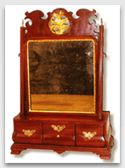

|
Bombe' Dressing Glass with Drawers c.1760-1790
This piece represents the highest style in Boston, the bombe' (swelled, kettle-shaped). The swelled sides and front in the casework were very popular in that particular geographical area for a long period
of time. This Dressing Glass, placed on the top of a Dressing Table, would have been used in the colonial home to assist in personal hygiene and dressing. It has diminutive ogee bracket fee,
carved cockbeading into the solid case, 22k water-gilded carved sight edge and carved floral decoration on the crest of the looking glass. The mirror glass is reproduction glass and the finish is hand-applied shellac. Mahogany.
H 32.1/2" W 21.1/2" D 8.1/4"
|
|
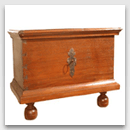

|
Pennsylvania Valuables Box
This reproduction walnut Valuables box is a hand dovetailed box seated upon lovely turned bun feet. The hand blacksmithed hardware features fabulous strap hinges and an exceptional crab/grab lock.
The interior sports a till complete with a hidden drawer.
H 12.5/8" W 20.1/4" D 11.3/4"
|
|
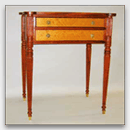

|
Federal Worktable
These striking tables were designed to be "work" or sewing tables for women in the new Republic. Turned legs of mahogany are hand reeded. It has a figured mahogany turret top and sides. The front
drawers are constructed from bird's eye maple surrounded by mahogany cockbeading. Hand applied Shellac finish.
|
|
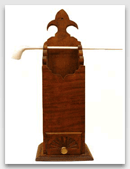

|
Colonial Pipe Box
The pipe Box was a common utensil in a colonial home or tavern. The clay pipes were stored on the tiered rack, after breaking off the tip for the next smoker. Flint and tinder were kept in the drawer below.
This reproduction is made from curly maple and finished with shellac. There are many variations of pipe boxes.
H 16.3/4" W 5.1/4" D 4.3/4"
|
|
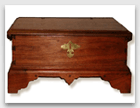

|
18th century Chester County, Pennsylvania Bible Box/Book Box
This walnut replica of an 18th century Chester County, Pennsylvania Bible Box is hand dovetailed and hand planed as was the original. The original was probably owned by a Quaker Family and certainly a valued
piece to that family because they may have housed the Holy Bible, a reference for belief and behavior as well as documents for family records, births, deaths, marriages, etc. The molded feet are cut by hand with a molding
plane, as are the lid undermoldings. The base and foot moldings are attached with wooden pegs, as in the original design. The box has exquisite hand blacksmithed hinges.
H 4.1/4" W 18" D 12"
|
|
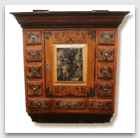

|
Pennsylvania German Painted Hanging Cupboard c.1775
This architectural cupboard made from clear white pine has lots of drawers, a lower open exterior shelf and an outstanding cornice complete with dentil work. The raised panel center door
masks two interior shelves, one of which would hold a charger (often a very expensive piece of pewter in the colonial home). The superb iron rattail hinges on this case are matched with an
equally fine Indian head escutcheon plate. Such respect was granted to pieces like this that it was often kept in a room of the house where it was held in high regard and locked on a
regular basis. The piece commanded respect in the PA German household. The tulip motif is central in the exquisite painted finish, faithfully recreated. It is suspended from the wall
with blacksmithed hangers on the back.
H 37.1/8" W 38.1/2" D 17.3/8"
|
|
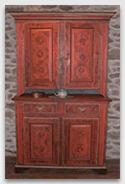

|
Pennsylvania German Step Back Cupboard c.1760's
This painted pine cupboard is a copy of an original Pennsylvania Step Back Cupboard, circa 1760's. Painted cupboards held the necessaries of the colonial kitchen in an organized fashion, yet still provided some color and interest in the
colonial household. This one is built using the same kind of traditional hand tools as craftsment in Colonial Pennsylvania would have used, including hand-cut dovetails, pegged mortise and tenon joints, hand cut molding from
wooden hand planes and hand planed surfaces throughout. Raised panel exterior doors. Note the interior spoon rack and plate rails. It features a traditionally painted exterior surface utilizing casein based paints as well as other
traditional period paint materials. The intricate paint design itself is based on an original Pennsylvania painted cupboard. The decorative rattail hinges are hand blacksmithed in York County. Great attention has benn given to the period details in the
execution of the construction as well as the finishing of this piece, making it an excellent example of the best of early Pennsylvania craftsmanship.
H 82.1/4" W 44" D 17.5/8"
|
|
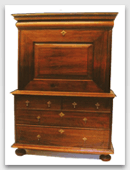

|
Philadelphia William and Mary Escrutoire/Scriptor
The fabulous reference "Worldly Goods" by Jack Lindsey cites the original of this piece is one of the first documented pieces built in Philadelphia in 1707, built by Edward Evans. Introduced in the
late 17th century, the escritoire (scrutoire, scitore, secretaire, secretary) is a secretary cabinet with a hinged fall front that becomes a writing surface.
Drawers and pigeonholes compose the upper section while the lower half is a bureau. Author Jack Lindsey in "Worldly Goods", states, "The Evans desk includes a flat, shallow drawer hidden by a torus molding (a large convex molding)
in the upper cornice, a feature found on few surviving Pennsylvania pieces but a popular device on English and Dutch cabinets of an earlier date." Pg 134. The dimensions of this eminently practical piece make it great for use in the modern home
or office. Spring locks and many hidden drawers.
H 66.1/2" W 44.1/2" D 19.1/2"
|
|
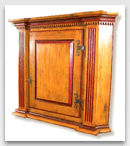

|
Pennsylvania German Hanging Corner Cupboard
This reproduction cupboard is constructed from thick, hand planed clear white pine and painted and patinated with traditional finishing materials to look 250 years old. It features outstanding hand cut dentil molding on the cornice,
hand cut fluted pilasters and a centrally located hand raised panel door. The hand made blacksmithed hardware is made in York County, PA, as well as the fabulous Indian head escutcheon and ram's head hinges terminating in rat-tails.
The interior is washed with milk paint and features scalloped shelving.
H 38.1/4" W 39"
|
|
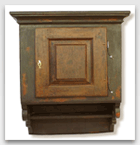

|
Chester County, PA Painted Hanging Cupboard
This faithful reproduction cupboard made from clear white pine is perfect for the functional modern kitchen or family room. The beautiful profiled sides are extremely eye-catching.
The raised panel door has a more complicated profile on both the stiles and rails as well as the central raised panel reveals, which is subtly decorative. The bold cornise is another decorative eye-catching feature.
A seemingly simple piece which draws the eye back again and again. Historically painted finish, with a scumbled decorative touch on the raised panel field as the original is decorated.
H 28.1/2" W 22" D 10.7/8"
|
|
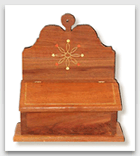

|
Colonial Pennsylvania Salt Box
The Pennsylvania Salt Box displayed here also typifies early Pennsylvania craftsmanship. Though built to be utilitarian in function, it was embellished in a particular fashion to brighten the user's daily
life, especially in the more affluent home. This salt box is constructed in the traditional manner, all hand tools. It is decorated with paint motifs rather unique to the Ephrata Cloisters. Others
are available which are painted to specific historic geographic locations or in the unique Line and Berry techniques, unique to Southeastern Pennsylvania. Pine.
H 16.3/8" W 13" D 6.3/8"
|
|
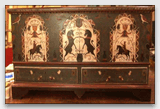

|
Pennsylvania German Decorated Chest
Monroe Fabian, in his outstanding book "The Pennsylvania-German Decorated Chest," says, "No form in the American decorative arts is more readily recognized for its aesthetic value and interest than the
Pennsylvania-German chest." Authentically built and decorated, clearly an outstanding American Folk Art example. While there are some basic construction methods and techniques to authentically
reproduce these wonderful boxes, there is a large variety of execution in box size, feet, moldings, the presence or absence of drawers, a variety of architectural features and certainly lots of options in the
execution of the paint motifs. Olde Mill has built and historically painted a variety of sizes and styles of the wonderful decorative form. Painted Pine.
|
|
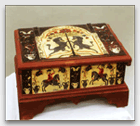

|
Painted Document Boxes
These boxes are clearly related to the Bible Box in design, just not as sacred in its purpose. They were, however, very important boxes in their own right in that they often housed very important documents
and probably legal tender. They were as plain or as embellished as the owner could afford, thus a wide range of decoration. These Document Boxes are authentically hand made in their construction and
dovetailing. Wooden pegs are used for assembly. Material is poplar with historically correct paint materials used for embellishment. Motifs used are from authentic Pennsylvania German artifacts,
borrowed from wooden objects, pottery, fraktur and other sources. Each one of these boxes is truly unique. Each is individually constructed and painted and no two will ever be exactly the same.
H 3.3/4" W 14.3/4" D 10.5/8" Depending on individual box.
|
|
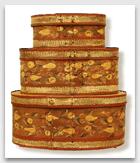

|
Brides Boxes, Painted
These wooden boxes were highly valued by prospective brides to keepsake their most valuable possessions. The glorious decorative painting signified marriage, good luck symbols and the like.
Sometimes the boxes were decorated with a man and a woman, sometimes animals, and even occasionally a gentleman on his horse. Some appear serious while others have a sense of humor,
at least to our modern eye. These unusual boxes are not to be confused with Shaker Oval Boxes, which indeed have an oval shape. Bride's Boxes have a "racetrack" shape. This requires a thin
piece of wood to be cut from the tree, smoothed by hand planing and steam-bent around a sized wooden mold. Matching bands are also thus constructed and bent to specifically match the box.
The sides are then hand stitched with thin strips of rawhide sinew and the tops and bottoms, which also require a lot of preparation, are custom fit to each specific box with wooden pegs. Next the
box is painted with historically correct materials and the embellished decoration is applied. Each of these boxes is individual and unique. They are available only on a very limited basis due to the extreme amount of time required to correctly
make the box and apply its decorative painted finish. The motifs used to paint the surface are acquired from original Bride's Boxes as well as other boxes similar in shape and design. The painted surfaces are
absolutely exquisite and capture the essence of the original boxes.
Large H 8.1/2" W 18.3/8" D 11.1/2"
Medium H 7.1/4" W 15.1/2" D 10.1/4"
Small H 5.3/8" W 11.1/2" D 7.1/4"
|
|